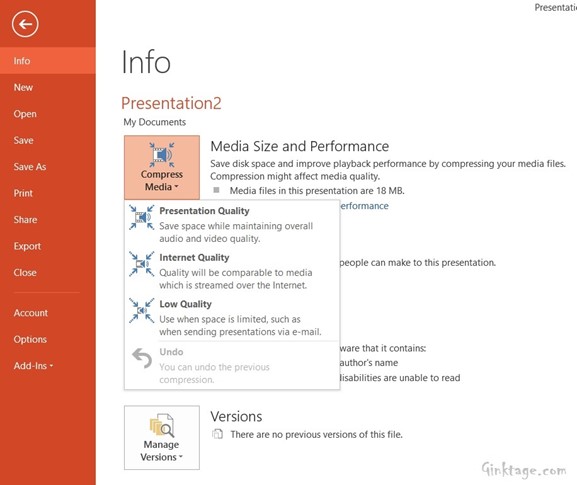
- #How to compress picture on powerpoint 2013 how to#
- #How to compress picture on powerpoint 2013 zip#
- #How to compress picture on powerpoint 2013 mac#
Insert a Background Picture in Powerpoint 2013
#How to compress picture on powerpoint 2013 how to#
Our tutorial below will show you where to go to insert a background picture into one of your slides, and it will show you how to apply the background picture to every slide of your presentation, if that is your desired result. You can make some changes to your background picture, such as adjusting the transparency and offsetting the picture from the center, which allows you to modify the way that the picture is displayed on your slides. So you might decide to learn how to add a background picture in Powerpoint 2013 if you determine that your audience will appreciate the addition to your presentation. OApp.Namespace(CVar(fPath)).CopyHere oApp.Namespace(CVar(tempName)).itemsįSO.Powerpoint presentations are very visual in nature, and are often improved with the help of visual aids like pictures and graphs. Set oApp = CreateObject("Shell.Application") 'Extract the files into the Destination folderĪctivePresentation.SaveAs fPath & "Extract.htm", ppSaveAsHTML, msoFalse 'Comment these lines if you do NOT want to delete all the files in the folder DefPath first if you want Set fDialog = Application.FileDialog(msoFileDialogOpen) Sub ExtractPPTFile(fPath As String, Optional HTMLExtract As Boolean = False) Set txtFile = FSO.CreateTextFile(txtFilePath, True, True) Set FSO = CreateObject("scripting.filesystemobject")Ĭase "GIF", "BMP", "PNG", "JPG" ' inspect only image files, modify as needed Sub InspectFiles(fPath As String, Optional HTMLExtract As Boolean = False)ĭim FSO As Object 'Scripting.FileSystemObjectĭim fileInfo() As Variant 'An array to hold file informationsĭim txtFilePath As String 'path for storing the log/reportĭim extractPath As String 'path for the exported HTML componentsĮxtractPath = fPath & IIf(HTMLExtract, "Extract_Files", "ppt\media") '"Extract_Files" for the HTML Shell "C:\WINDOWS\explorer.exe """ & DefPath, vbNormalFocus 'Use Shell to open the destination folder Option ExplicitĭefPath = "C:\Users\" & Environ("username") & "\desktop\PPT_Report\" ' "\" Then
#How to compress picture on powerpoint 2013 zip#
I initially did the HTML because it seemed easier, but then figured out how to do the ZIP version so I include both options. Optional HTMLExtract allows you to convert from the ZIP or HTML. I played around a bit with Ron DeBruin's functions and put this one together pretty quickly, I am not sure how useful it will be for OP but perhaps will be valuable to someone else in the future.

#How to compress picture on powerpoint 2013 mac#
This will NOT work for PPT 2011 / Mac version of PowerPoint.


When you enable Review, PowerPoint stores a copy of the original presentation as a hidden OLE object - this is the baseline for comparisons with the presentation itself as it's edited later. PowerPoint has some default settings that will work against you when you're trying to keep file size down.Īn embedded or linked object's WMF includes any bitmap data, your PPTįile bloats.> can include bitmap images, but only as

For instance about WMFs, slide master templates, raster images, etc. The PPTFAQ site has a lot of other potentially helpful information about what can contribute to your file bloat. In any case, it can be done, by someone who knows a lot about PowerPoint. There appears to be an Add-in which PPTFAQ links to, which will identify the sources of bloat, although it does not work for PPT 2007+ file formats (PPTM/PPTX, etc.), and it may not work for PPT versions 2007+


 0 kommentar(er)
0 kommentar(er)
